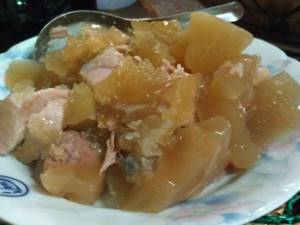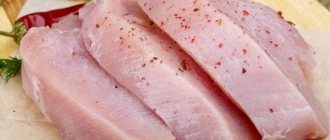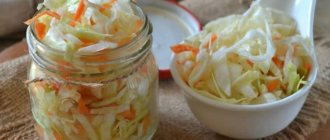Hello, friends. Let's talk today about jellied meat per 100 calories. And per 100 what, liters, kilograms, or maybe rubles. Probably still a gram, this measure of weight is better suited to today’s topic.
It is more attractive to people interested in this issue. Although any of these definitions is applicable to such a product, depending on what state it is in, liquid, solid or intangible, while it lies on the shelf in the store and waits for you to pay a hundred rubles for it.
And what worries you most at this moment is not the price tag, but how much it will blow you away when you eat it and how much fat you will add under your chin.
Of course, I joke a little, but as you know, every joke has a grain of humor. I'm kidding again. Although-I-I...! A good mood promotes communication and mutual affection, which is what we should strive for.
Let's go through the main, more common types of jellied meat, consider its value in calories and try to choose, each for himself, the product that is most acceptable.
Below we will try a recipe that is not only easy to prepare, but also no less easy to use. After which, let’s part nicely, I would really like to have no mutual claims, although claims to the author are welcome, they help improve our communication with you. Let's get started.
What is jellied meat and how did it appear?
In essence, jellied meat is a transparent gelatinous jelly left after boiling a thick broth. The dish first appeared in the 14th century in France, where wealthy people could afford very rich meat soups. Initially, French chefs were skeptical about the taste of jelly, but over time, a dish called galantine was invented. To create it, processed meat was twisted into a jelly state, and then sent back to the broth and kept in the cold for some time.
Russian jellied meat appeared around the same time - although initially it was prepared from simple meat scraps. The tradition of seasoning jelly with spices and herbs arose later, and came precisely from Europe.
Chemical composition of jellied meat
Many people like the taste of jellied meat, but they value the product primarily for its beneficial properties. Namely, it contains:
- useful minerals - copper, potassium, phosphorus;
- elements fluorine, sulfur, rubidium;
- aluminum and boron, calcium and vanadium;
- polyunsaturated fatty acids;
- collagen and glycine;
- gelatin;
- retinol;
- valuable aliphatic amino acid;
- vitamins - C, B9, A.
Even a small portion of high-quality jelly brings great benefits to the body.
How many calories are in jellied meat
Since jellied meat is made from different types of meat, the calorie content may vary.
- Pork jelly is the most nutritious - calorie content ranges from 340 to 390 calories per 100 g of product.
- In second place is beef jellied meat - it contains from 130 to 180 calories.
- The least calorie-rich jellied meat is made from lean poultry meat - turkey or chicken. It contains from 80 to 200 calories.
Pork jellied meat is recommended to be consumed only by very healthy people - for many ailments, a fatty dish will be harmful. The properties of jellies made from poultry and beef are considered the most dietary.
Differences between jellied meat and other dishes
From jelly
The differences between these dishes are minor, but they exist. To prepare jelly, only beef is used; other types of meat are not suitable. Usually the drumsticks are used, and tongue and other parts of the carcass are often added. Beef broth takes several hours longer to cook than pork broth; it is less fatty, so the finished dish will not be as dense as classic jellied meat. The color is darker and more saturated.
Jellied meat is prepared in several stages, separately boiling the meat and gelling components. For brawn, all ingredients are boiled together, which ultimately reduces cooking time. Thus, finding out how many calories are in jelly is simple: the same as in beef jellied meat.
From aspic
This dish belongs not to Russian, but to French cuisine. Chicken, turkey or lean fish are used as a base. Due to the low fat content, the broth does not solidify on its own, so gelatin or other thickeners are added to it. The filler looks very beautiful; all the components are visible through the transparent base. To make it even more beautiful, add something bright, for example, shaped carrots or green peas.
Low-calorie jellied meat recipes, which are in high demand among supporters of proper nutrition, are essentially aspic.
From brawn
The brawn has a firmer texture because it contains more meat. Jelly is not the main part of the dish, but only a connecting link. Skins, ears, and diaphragms are used as gelling components; they are often stuffed into a natural casing, and the result is something similar to sausage with a small amount of congealed broth.
What are the health benefits of jellied meat?
Meat jelly is not only nutritious, it has a pleasant taste and is beneficial for the body. Specific valuable properties depend on what meat the dish is prepared from. But there are several common qualities inherent in any jelly. Namely, the product has a positive effect:
- for immunity - retinol present in the dish successfully fights viruses and infections;
- on joints - gelatin in the product strengthens bone and connective tissue;
- on the nervous system - glycine in the jelly improves brain function and helps get rid of depression;
- on metabolic processes - in particular, the product’s properties are very effective for hangover syndrome.
Jellied meat for treating joints
Among the beneficial properties of the product, one valuable quality is especially noted - a positive effect on joints and connective tissues. The fact is that any jelly, especially beef, contains a high percentage of animal protein. It is protein that is largely responsible for the rapid restoration of tendons, cartilage, ligaments and bones.
Regular consumption of beef or pork jelly is highly recommended for athletes. During training, their joints are subjected to particularly heavy loads and are often injured. The protein, collagen and carotene in the product can protect bone tissue from destruction, and in addition, will further increase physical endurance.
The benefits of pork jellied meat
The beneficial properties of a product made from pork knuckle, tail, ears or legs are dictated by the valuable qualities of the pork itself. In particular, it contains amino acids and iron, vitamin B12 and myoglobin, animal fat.
Pork jellied meat:
- effectively protects the body from vitamin deficiency;
- replenishes calcium reserves;
- has a beneficial effect on the condition of blood vessels and the heart.
Attention! The benefit of jellied pork legs for men is that the properties of the product serve as a prevention of prostatitis and improve potency.
The benefits of beef jellied meat
Jelly made from beef is less fatty than pork and is much better digestible, by as much as 76%. Therefore, you can use the product even with many gastrointestinal diseases; it will not cause harm.
Beef jelly contains a large amount of vitamin A, so it is extremely beneficial for eye health. The product contains carotene, which strengthens muscle, bone and connective tissues and promotes their recovery. The benefits of jellied beef legs will be especially great for athletes whose muscles and joints are subject to special stress.
Who should not use

Pork cold appetizers are prohibited for people who suffer from atherosclerosis, as it increases the concentration of cholesterol. This dish puts a strain on the liver and pancreas, so it is contraindicated for liver diseases and pancreatitis. Fatty jellied meat can provoke an exacerbation of chronic diseases.
For gastritis, it is not recommended to eat jelly with ginger, garlic, onion, horseradish or pepper.
Supplement the dish with a minimal amount of spices to slightly improve the taste, but not harm your health.
When losing weight, it is forbidden to eat pork aspic, as it provokes an increase in adipose tissue. In this case, replace fatty meat with chicken, turkey or other dietary product.
What are the benefits of chicken jellied meat?
A product made from chicken or turkey meat is most useful for those who want to lose weight. The calorie content of jelly is very low, and it contains a lot of valuable substances. These are the main vitamins C, A, B, elements: iron and magnesium, calcium.
Choline in chicken or turkey jellied meat helps regulate metabolism and has a beneficial effect on the nervous system. The collagen present in the product has a good effect on hair and skin. This is also why the benefits of jellied chicken feet will be especially great for the fair sex.
Calorie content of jellied meat: beef, chicken, pork
You are here: Home > Articles > Cooking > Calorie content of foods
April 3, 2015 | views: 24,248
Jellied meat is one of the favorite dishes of Russian national cuisine, along with borscht and pancakes. Essentially it is a cool broth with pieces of meat that has a jelly-like state. Mainly for the production of jellied meat, by-products of ungulates - pigs and cows - are utilized. These are heads, legs and tails. How many calories are in aspic from the store can be found on the label.

To calculate the calorie content of homemade jellied meat, you need to add up the indicators of all the ingredients used: bones, fat, cartilage, meat, spices and other products. In addition, the calorie content of chicken jellied meat is significantly different from the calorie content of jellied pork legs. The method of preparing the dish also plays a big role. Therefore, different authors report different numbers on how many calories are in chicken jellied meat or the calorie content of turkey jellied meat.
Calorie content of beef jellied meat
This is the most dietary jellied meat, so to speak. The calorie content per 100 grams of beef jellied meat is a little over 80 kilocalories. Thanks to such low indicators, this dish can be considered dietary if consumed in reasonable quantities. The low calorie content of beef jellied meat will not harm your figure. But you should understand that the calorie content of beef jellied meat will be high if you eat a large portion.
Calorie content of chicken jellied meat
The calorie content of jellied chicken feet is perhaps the lowest. The calorie content of this jellied meat is only 120 kilocalories. These parts of the bird's body are devoid of fat, and chicken meat is dietary. But if the dish is prepared from whole poultry, then the calorie content of chicken jellied meat exceeds the calorie content of beef jellied meat. The calorie content per 100 grams of chicken jellied meat is 200 kilocalories. The low calorie content of chicken jellied meat will not bring you extra pounds.
Calorie content of jellied pork
Pork jellied meat has the highest calorie content. This is explained by the fact that animals are initially raised not only for meat, but also for lard. The calorie content of pork jellied meat varies from 190 to 330 kilocalories per 100 grams. ready dish. The indicators depend on the fat content of the product chosen for preparing the dish. In any case, the high calorie content of jellied meat from this animal indicates that it is inadvisable to use it during a diet or on fasting days.
Calorie content of different types of jelly

Advantages of jellied meat
No less important question than how many calories are in jellied meat is the question of the benefits of this dish. In various cuisines of the world there are dishes similar to our jelly, that is, many people value the taste and nutrients. First of all, it is worth saying that jelly is a source of valuable collagen protein, which is boiled down from cartilage, bones and other products during a long cooking process. This substance is extremely beneficial to the cells of the body, especially the skin. They become elastic, elastic, wrinkles and folds disappear. And this fact is also very important for people who want to look and feel good. Regular inclusion of jellied meat in the diet is useful for the prevention of diseases of bones and joints.
Jelly contains a very valuable substance that helps strengthen the immune system and helps the body absorb calcium. Almost all B vitamins are present in any type of jellied meat. It is worth noting that the most useful amino acid, glycine, which stimulates brain and nervous activity, is extracted from jellied meat. This drug is very popular because it increases concentration, improves the ability to remember and generally has a beneficial effect on human performance. Therefore, the question of how many calories are in jellied meat is, on the one hand, legitimate, but on the other hand, this dish has a lot of irreplaceable and useful properties. Jellied meat should not be considered as a holiday dish, since it is a source of invaluable substances that the body needs every day.
Harm of eating jelly
But in addition to valuable substances, jellied meat also contains harmful ones. For example, strong broth is a dish containing a high concentration of cholesterol, and, therefore, abusing this dish is not only not recommended, but also extremely harmful. Cholesterol accumulates on blood vessels, narrowing them. This is extremely dangerous, as it is fraught with serious disruptions to the cardiovascular system. In addition, consuming large amounts of jelly puts a serious strain on the liver and slows down the body's metabolism.
All this leads to significant weight gain and various liver diseases. I would also like to note that there is a dish very similar to jellied meat. This is aspic. It is prepared from a weaker broth using gelatin. As a result, the dish has practically the same beneficial properties, but its calorie content is lower. And it also does less harm. Aspic, as a rule, is prepared with the addition of olives, herbs, lemon, garlic, which not only improves its taste, but also increases its beneficial properties. However, jellied meat, despite some harm, has remained a favorite dish of many nationalities for centuries.
1 comment on this post
- Carrie
Jun 28, 2021 at 3:36It is best to buy such an important component in jellied meat as meat at the market, because there it is guaranteed not to be frozen.
Leave your comment: Cancel
Can jellied meat be used by pregnant and lactating women?
During the period of bearing a child, jelly can bring both benefit and harm. The main danger is that the product can increase cholesterol levels in the blood and cause excess weight gain.
However, the product also has benefits for pregnant women. Jellied meat improves hemoglobin production, helps absorb calcium, removes toxins and strengthens the immune system. Therefore, you can still take the product during pregnancy - just in small quantities, and after consulting a doctor.
Jellied meat is also approved for use during breastfeeding. It does not have a negative effect on the baby's health. But the product should be consumed without seasonings and herbs, in order to avoid allergies and colic in the baby.
Is it worth eating while losing weight?

When on a diet, jellied meat is consumed instead of 1-2 main meals. It is important to select low-calorie foods and add vegetables to the broth to increase the benefits of the jelly.
The duration of the cold diet is 1 week. For this period, a menu should be drawn up taking into account the proportions of BJU.
If you want to lose excess weight, then choose lean meat for the dish: chicken, beef, turkey. Avoid hot seasonings, numerous spices, or reduce their quantity.
Make sure that the volume of water is greater than the amount of meat. Eat jellied meat in small portions (no more than 250 g at a time).
After a week-long diet on jellied meat, you can get rid of 2-3 kg. According to nutritionists, this is the safest rate of weight loss. After changing your eating style, metabolism and fat breakdown accelerate. You can follow the aspic diet every month.
When consuming meat and bone broth, there is no feeling of hunger, dizziness, weakness, or nausea. Even a minimal portion of a cold snack will help you feel full for a long time.
You may also be interested in: Chicken liver for weight loss
At what age can jellied meat be given to children?
Classic jelly is too “heavy” food for a child’s body. But the beneficial properties of the product are still important for growing babies. Therefore, children from 6 or 7 months of age are recommended to be offered a special homemade baby jellied meat - made from chicken meat, without salt and other seasonings and spices. The benefit of chicken aspic will be that the product will strengthen the child’s immunity and promote the development of bones and muscles.
You should start complementary feeding using an amount of no more than a quarter of a teaspoon. If there is no negative reaction, then gradually, by the time the child is one year old, the amount of jelly can be increased to 50 g per day.
Important! Since even low-fat and unsalted jellied meat can harm a child, it can be introduced into the diet only after consultation with a pediatrician.
Recipes for the lowest calorie jellied meat: step-by-step cooking instructions
Classic version
A cold appetizer according to this recipe can be prepared as easily and quickly as possible (without taking into account the additional time for the final hardening of the jellied meat). The following products are needed for cooking:
- chicken breast – 1 kg;
- carrots – 1 pc.;
- broth - 1 l;
- gelatin – 30 g;
- onion – 1 pc.;
- garlic – 3 cloves;
- eggs – 3 pcs.;
- greens - a small bunch.
First, rinse the fillet thoroughly and fill it with water. Place the container on the fire and cook the chicken broth. After boiling, watch for the accumulation of foam and remove it regularly with a slotted spoon. Then peel the onions and carrots, place them whole in the pan with the chicken and cook for about 1 hour. Pour the gelatin from the bag into a deep container and fill it with water, wait until it swells completely. Strain the broth from the fillet and vegetables thoroughly and remove excess fat with a spoon.

Add gelatin powder to it and mix thoroughly. Cut the boiled breast into small pieces or disassemble it directly with your hands. Peel the pre-boiled eggs and cut into neat slices, chop the carrots into slices. Place meat, chopped eggs, carrots, garlic and chopped herbs into a deep dish. Pour the gelatin mixture over the ingredients and place in the refrigerator to set (will take about 4-5 hours).
Note! A dish based on chicken breast goes well with spicy additives - mustard, horseradish, garlic sauce.
In a slow cooker
A delicious recipe for jellied meat with reduced calorie content, specially selected for preparation in a home slow cooker. The dish turns out to be as tasty and tender as possible. Required list of products:
- whole chicken – 1200 grams;
- gelatin – 20 grams;
- onion – 1 piece;
- carrots – 1 piece;
- water – 1.2 liters;
- garlic – 1 clove;
- lettuce leaves - 1 piece;
- corn in a jar - 3 tbsp. l.;
- allspice (peas) – 7 pieces;
- sea salt, ground pepper - add to taste.
Rinse the chicken carcass thoroughly with water and divide into 4 parts, then place them in the multicooker bowl. Add onions, whole carrots and peppercorns to them. Pour in purified water, salt and pepper thoroughly. Activate the “Broth” mode and cook the dish for 1.5 hours. Approximately 3-4 times during this time, skim off any foam that appears. Then turn on the “Soup” mode for 2 hours.
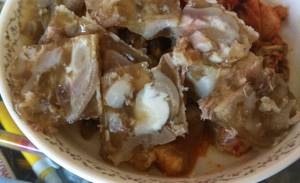
After this, remove the meat and boiled vegetables to a plate. Carefully separate the chicken meat from the bones, remove the skin and finely chop it. Cut the carrots into small cubes. Strain the prepared broth through cheesecloth. Pour out one glass of liquid and soak gelatin in it for 30 minutes. Next, part of the broth with gelatin should be placed in a water bath for several minutes, stirring occasionally.
Next, pour the mixture into the remaining broth, adding peeled and chopped garlic, sea salt and pepper. Then pour the mixture into the prepared pans and add chicken, corn and chopped carrots. Place the dish in the refrigerator to set for about 5 hours. Serve the aspic with horseradish and plenty of herbs to taste.
With bell pepper
A tasty version of the dish with the addition of sweet pepper. For cooking you will need the following products:
- boiled fillet – 160 grams;
- gelatin (powder) – 10 grams;
- chicken broth – 250 grams;
- sweet pepper – 1 piece;
- carrots – 1 piece;
- bay leaf – 2 pieces;
- sea salt, ground pepper - add to taste;
- greens - a small bunch.
Cook chicken breast broth with a little salt, bay leaf and spices (total time - 70 minutes). Don't forget to skim off the foam to make the liquid clear. Next, cool the broth and pour gelatin into it, mix the ingredients thoroughly and let it brew for 10 minutes. Heat the container with gelatin in a water bath until the small granules are completely dissolved, and then cool.

Rinse the bell pepper with water and cut into rings, then place on the bottom of the prepared pan. Place chopped meat, chopped herbs and carrot slices on top. Carefully pour the broth over the ingredients and place in the refrigerator overnight to set. Serve jellied meat with additional fresh herbs.
With eggs
A fairly satisfying version of aspic that can be prepared on a diet. Required list of products:
- eggs – 5 pieces;
- chicken fillet – 1 piece;
- broth - 1 liter;
- gelatin – 20 grams;
- olives – 6 pieces;
- canned peas from a jar - 4 tbsp. l.;
- salt, spices - add to taste.
Boil the chicken meat in water along with salt and spices: after boiling, this broth should boil for about 40 minutes. Beat the eggs with a fork, add a small amount of salt and bake in the oven (you should get a thin baked omelette). Roll the cooled omelette into a tight roll and cut it into pieces about 1 cm thick. Also chop the olives, cut the fillet into small cubes.
Prepare small forms: place an omelette, peas from a jar, olives and boiled fillet pieces on the bottom. Dilute gelatin in 100 ml of water and wait until it swells (about 30-40 minutes). Next, mix it with the broth. Pour it into the molds and place the dish in the refrigerator for at least 6 hours.
Note! In an alternative version of the recipe, the aspic is poured into prepared egg shells for creative serving to guests. To make such a “container” stable, the shells are placed in an egg tray.
How to cook jellied meat at home
You don’t have to buy classic jelly in a store—you can make the delicacy yourself at home. Since the benefits of jellied beef are the greatest, and the harm is minimal, it is recommended to cook it. You will need to take the following products:
- cleaned beef leg, or fetlock joint - 1.3 kg;
- beef of the highest category - 800 g;
- chicken breast - 1.8 kg;
- water - 3 l;
- carrots - 300 g;
- onions - 350 g;
- a little garlic - about 40 g;
- parsley root - 250 g.
The dish takes a long time to prepare, but without any particular difficulties.
- The beef leg is chopped and poured with 2-3 liters of water, and then boiled for 8 hours over low heat, not forgetting to skim off the foam.
- About 4 hours after the start of cooking, chicken and beef are added to the fetlock joint.
- After 7.5 hours, add vegetables to the pan.
When the components of the future jelly are cooked, the meat is cooled to a warm temperature, chopped into small pieces or passed through a meat grinder, after removing all the veins and bones. The resulting minced meat is again placed in the strained broth, salted, cooked for another 20 minutes, then garlic is added.
The finished jelly is distributed into molds and left for several hours in the refrigerator so that the jelly hardens properly.
Low-calorie poultry recipe
Such jellied meat will contain only fifty to seventy calories per 100 grams of product.
To make the recipe a reality, you will need
- Turkey meat - two kilograms
- Chicken - five hundred grams.
- chicken feet - five hundred to six hundred grams.
- Garlic - five to six cloves.
- A couple of bay leaves.
- Salt, pepper.
Cooking process.
After thoroughly washing all the goodness, we put it in a deep pan. Fill with five liters of water and put on fire.

Bring to a boil, remove the foam, add garlic, bay leaf, add salt to taste and continue cooking for four to five hours, until the meat begins to pull away from the bones.
Then, using a slotted spoon, put all the contents of the broth into a convenient container and cool.
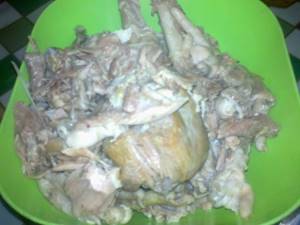
Separate the yummy stuff from the bones (not the yummy stuff).
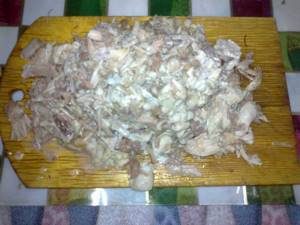
We put the edible stuff into shapes, and give the inedible stuff to the dog.
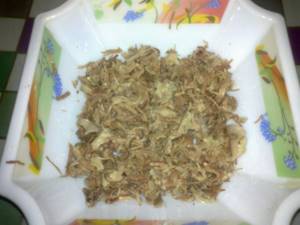
Pour the broth and put it in the refrigerator. In six hours, the excellent jellied meat will be ready.
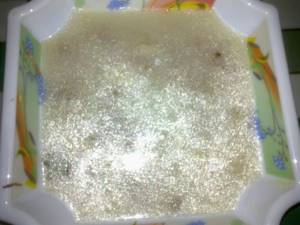
The broth can be strained, then the product will be clearer. Quick and simple, like everything ingenious.
Harm of jellied meat and contraindications
No matter how great the benefits of a product, sometimes it can cause harm. The main risks are related to the fact that:
- fatty thick jellied meat contains quite a lot of cholesterol, so it can negatively affect blood vessels, liver and heart;
- the product contains growth hormone - it is harmful in large quantities or in the presence of allergies;
- Pork jelly contains a substance called histamine, which is harmful to people with impaired bile production;
- Jelly is high in calories and can contribute to weight gain if consumed indefinitely.
Thus, we can identify a list of diseases and conditions for which jellied meat is contraindicated. Namely, its properties will cause harm:
- with a tendency to obesity;
- if there is an individual intolerance to any components;
- for diseases of the gallbladder;
- for gout;
- for severe vascular and heart diseases;
- in case of intestinal dysfunction, jellied meat, especially pork, is difficult to digest.
We recommend reading: Benefits of bell pepper, properties
Advice! If you have a sensitive stomach, you should not use a product with hot spices: pepper, ginger, garlic.
We recommend reading: Chili peppers: benefits and harms, properties, how to eat them
Nutritionists recommend enjoying the product no more than 2 times a week in small portions. Then the health benefits and harms of jellied meat will be balanced.
Cook with a whole bird or just chicken breast
There are many recipes for dietary aspic with different ingredients. Culinary publications advise preparing such a dish from a rooster - the cut up carcass contains many gelling components that make the jellied meat more elastic and appetizing in appearance. However, if you add a sufficient portion of gelatin, a whole chicken, its individual parts or fillet of your choice will also work.
The main point is to cook a high-quality broth based on the selected meat according to all the rules. It should have a golden color and sufficient transparency without clouding, and a pleasant aroma.
